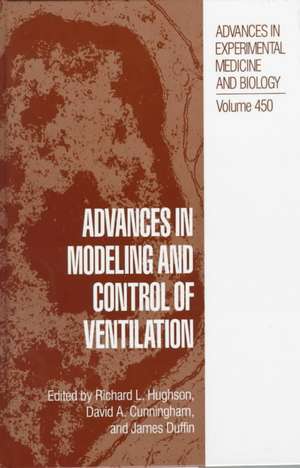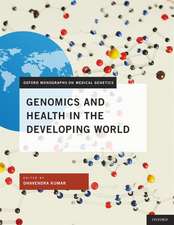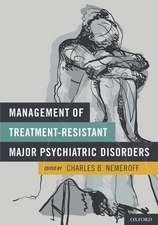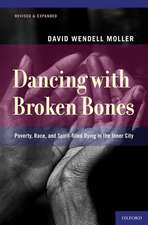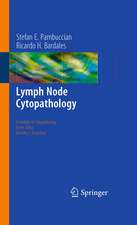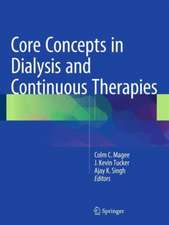Advances in Modeling and Control of Ventilation: Advances in Experimental Medicine and Biology, cartea 450
Editat de Richard L. Hughson, David A. Cunningham, James Duffinen Limba Engleză Hardback – 31 oct 1998
| Toate formatele și edițiile | Preț | Express |
|---|---|---|
| Paperback (1) | 1407.51 lei 6-8 săpt. | |
| Springer Us – iul 2013 | 1407.51 lei 6-8 săpt. | |
| Hardback (1) | 1413.35 lei 6-8 săpt. | |
| Springer Us – 31 oct 1998 | 1413.35 lei 6-8 săpt. |
Din seria Advances in Experimental Medicine and Biology
- 9%
 Preț: 719.56 lei
Preț: 719.56 lei - 5%
 Preț: 717.00 lei
Preț: 717.00 lei - 5%
 Preț: 717.00 lei
Preț: 717.00 lei - 15%
 Preț: 640.24 lei
Preț: 640.24 lei - 5%
 Preț: 715.71 lei
Preț: 715.71 lei - 5%
 Preț: 716.28 lei
Preț: 716.28 lei - 20%
 Preț: 691.93 lei
Preț: 691.93 lei - 5%
 Preț: 1031.00 lei
Preț: 1031.00 lei - 5%
 Preț: 820.42 lei
Preț: 820.42 lei - 5%
 Preț: 716.28 lei
Preț: 716.28 lei - 15%
 Preț: 641.38 lei
Preț: 641.38 lei - 5%
 Preț: 717.20 lei
Preț: 717.20 lei - 5%
 Preț: 715.35 lei
Preț: 715.35 lei - 5%
 Preț: 1113.83 lei
Preț: 1113.83 lei - 20%
 Preț: 1161.71 lei
Preț: 1161.71 lei - 5%
 Preț: 1170.51 lei
Preț: 1170.51 lei - 18%
 Preț: 1119.87 lei
Preț: 1119.87 lei - 5%
 Preț: 1288.48 lei
Preț: 1288.48 lei - 5%
 Preț: 1164.67 lei
Preț: 1164.67 lei - 5%
 Preț: 1101.73 lei
Preț: 1101.73 lei - 18%
 Preț: 1123.67 lei
Preț: 1123.67 lei - 5%
 Preț: 1435.64 lei
Preț: 1435.64 lei - 20%
 Preț: 1044.10 lei
Preț: 1044.10 lei - 18%
 Preț: 946.39 lei
Preț: 946.39 lei - 5%
 Preț: 292.57 lei
Preț: 292.57 lei - 18%
 Preț: 957.62 lei
Preț: 957.62 lei - 18%
 Preț: 1235.76 lei
Preț: 1235.76 lei - 5%
 Preț: 1231.55 lei
Preț: 1231.55 lei - 5%
 Preț: 1292.30 lei
Preț: 1292.30 lei - 5%
 Preț: 1102.10 lei
Preț: 1102.10 lei - 18%
 Preț: 1132.81 lei
Preț: 1132.81 lei - 5%
 Preț: 1165.19 lei
Preț: 1165.19 lei - 5%
 Preț: 1418.48 lei
Preț: 1418.48 lei - 5%
 Preț: 1305.63 lei
Preț: 1305.63 lei - 18%
 Preț: 1417.72 lei
Preț: 1417.72 lei - 18%
 Preț: 1412.99 lei
Preț: 1412.99 lei - 24%
 Preț: 806.15 lei
Preț: 806.15 lei - 18%
 Preț: 1243.29 lei
Preț: 1243.29 lei - 5%
 Preț: 1429.44 lei
Preț: 1429.44 lei - 5%
 Preț: 1618.70 lei
Preț: 1618.70 lei - 5%
 Preț: 1305.12 lei
Preț: 1305.12 lei - 18%
 Preț: 1124.92 lei
Preț: 1124.92 lei - 5%
 Preț: 1097.54 lei
Preț: 1097.54 lei - 15%
 Preț: 649.87 lei
Preț: 649.87 lei - 5%
 Preț: 1097.54 lei
Preț: 1097.54 lei - 18%
 Preț: 945.79 lei
Preț: 945.79 lei - 5%
 Preț: 1123.13 lei
Preț: 1123.13 lei - 20%
 Preț: 816.43 lei
Preț: 816.43 lei
Preț: 1413.35 lei
Preț vechi: 1487.73 lei
-5% Nou
Puncte Express: 2120
Preț estimativ în valută:
270.47€ • 280.78$ • 225.53£
270.47€ • 280.78$ • 225.53£
Carte tipărită la comandă
Livrare economică 22 martie-05 aprilie
Preluare comenzi: 021 569.72.76
Specificații
ISBN-13: 9780306460234
ISBN-10: 0306460238
Pagini: 241
Ilustrații: XIII, 241 p.
Dimensiuni: 156 x 234 x 21 mm
Greutate: 0.51 kg
Ediția:1999
Editura: Springer Us
Colecția Springer
Seria Advances in Experimental Medicine and Biology
Locul publicării:New York, NY, United States
ISBN-10: 0306460238
Pagini: 241
Ilustrații: XIII, 241 p.
Dimensiuni: 156 x 234 x 21 mm
Greutate: 0.51 kg
Ediția:1999
Editura: Springer Us
Colecția Springer
Seria Advances in Experimental Medicine and Biology
Locul publicării:New York, NY, United States
Public țintă
ResearchCuprins
1. Effect of Prior O2 Breathing on Hypoxic Hypercapnic Ventilatory Responses in Humans.- 2. Inhibitory Dopaminergic Mechanisms Are Functional in Peripherally Chemodenervated Goats.- 3. Effect of 8 Hours of Isocapnic/Poikilocapnic Hypoxia on the Ventilatory Response to CO2.- 4. Ventilatory Responses to Hypoxia after 6 Hours Passive Hyperventilation in Humans.- 5. Ventilatory Effects of 8 Hours of Isocapnic Hypoxia with and without ß-Blockade.- 6. Modulation of Ventilatory Sensitivity to Hypoxia by Dopamine and Domperidone before and after Prolonged Exposure to Hypoxia in Humans.- 7. Changes in Respiratory Control during and after 48 Hours of Both Isocapnic and Poikilocapnic Hypoxia in Humans.- 8. Chemoreflex Effects of Low Dose Sevoflurane in Humans.- 9. Dynamics of the Cerebral Blood Flow Response to Sustained Euoxic Hypocapnia in Humans.- 10. Evidence for a Central Role of Protein Kinase C in Modulation of the Hypoxic Ventilatory Response in the Rat.- 11. Synaptic Connections to Phrenic Motoneurons in the Decerebrate Rat.- 12. Phrenic Nerve Response to Glutamate Antagonist Microinjection in the Ventral Medulla.- 13. Axonal Projections from the Pontine Parabrachial-Kölliker-Fuse Nuclei to the Bötzinger Complex as Revealed by Antidromic Stimulation in Cats.- 14. Hebbian Covariance Learning: A Nexus for Respiratory Variability, Memory, and Optimization?.- 15. Performances of Different Control Laws for Automatic Oxygen Supply for COPD Patients.- 16. Techniques for Assessing the Shape of Respiratory Flow Profiles from Data Containing Marked Breath-by-Breath Respiratory Variability.- 17. The Expiratory Flow Pattern and the Neuromuscular Control of Breathing in Cats.- 18. Phase Relations between Rhythmical Forearm Movements and Breathing under Normacapnic and HypercapnicConditions.- 19. Temporal Correlation in Phrenic Neural Activity.- 20. Methods of Assessing Respiratory Impedance during Flow Limited and Non-Flow Limited Inspirations.- 21. Human Ventilatory Response to Immersion of the Face in Cool Water.- 22. Ventilatory Response to Passive Head Up Tilt.- 23. Do Sex-Related Differences Exist in the Respiratory Pharmacology of Opioids?.- 24. Are the Respiratory Responses to Changes in Ventilatory Assist Optimized?.- 25. Selective Depression of Peripheral Chemoreflex Loop by Sevoflurane in Lightly Anesthetized Cats.- 26. Pulmonary Rapidly Adapting Receptors and Airway Constriction.- 27. The Effect of Eucapnic and Isocapnic Volitional Hyperventilation upon Breathlessness.- 28. Influence of Low Dose Dopamine on the Heart Rate and Ventilatory Responses to Sustained Isocapnic Hypoxia.- 29. Ondine’s Curse and Its Inverse Syndrome: Respiratory Failure in Autonomic vs. Voluntary Control.- 30. Chemoreflex Model Parameters Measurement.- 31. Ventilatory Response to Imagination of Exercise and Altered Perception of Exercise Load under Hypnosis.- 32. Cardiolocomotor Interactions during Dynamic Handgrip and Knee Extension Exercises: Phase-Locked Synchronization and Its Physiological Implications.- 33. V?e-V?co2 Relationship in Transient Responses to Step-Load Exercise from Rest to Recovery.- 34. The Influence of Hypercapnic Hyperpnea on the Interaction between Breathing and Finger Tracking Movements in Humans.- 35. Characteristics of the VO2 Slow Component during Heavy Exercise in Humans Aged 30 to 80 Years.- 36. Voice, Breathing, and the Control of Exercise Intensity.- 37. Pulmonary Training May Alter Exertional Dyspnea and Fatigue via an Exercise-like Training Effect of a Lowered Heart Rate.
